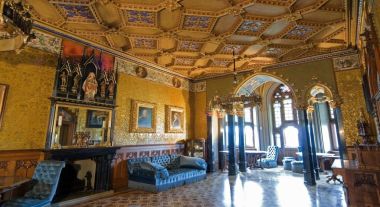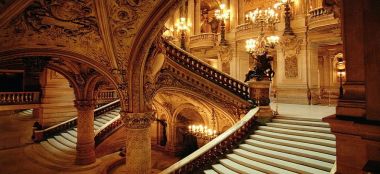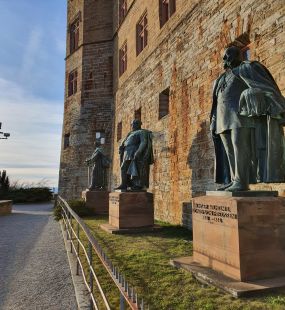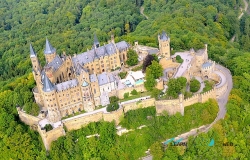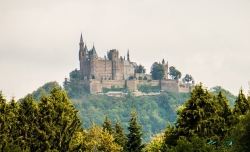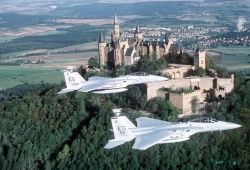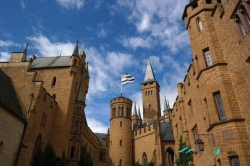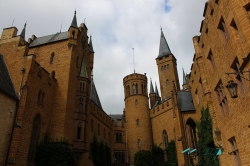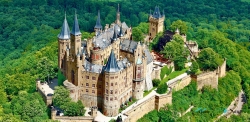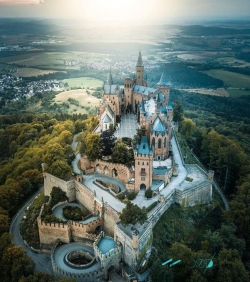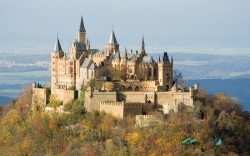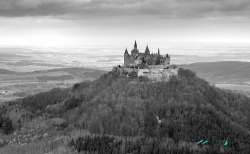The Hohenzollern house was first mentioned historically in 1061 ("Wezil et Burchardus de Zolorin"). The first mention of the castle building ("Castro Zolre") dates from 1267. The appearance, size and furnishings of this first castle are unknown, but research suggests that the castle was built in the first half of the 11th century . For the time, it must have been a large and artistically valuable facility. In contemporary sources it was praised as the "crown of all castles in Swabia" and as "the most vestigial house in German lands". Nevertheless, it was completely destroyed in 1423.
From 1454 the second Hohenzollern Castle was built larger and more fortified than before. The castle was later expanded into a fortress in view of the 30 Years War, after which the owners changed several times. However, the structural maintenance was not carried out to the extent required, with the result that it increasingly fell into disrepair and at the beginning of the 19th century only presented itself as a ruin.
In 1819, Crown Prince Friedrich Wilhelm von Prussia made the decision to rebuild the family seat of the House of Hohenzollern. Later, as King Friedrich Wilhelm IV., He wrote in a letter from 1844: "The memory of J.19 is extremely lovely to me and like a beautiful dream, especially the sunset that we saw from one of the castle bastions ... Well is a childhood dream - wish to see the Hohenzollern made habitable again ... "
From 1850 he realized his long-cherished dream and created one of the most imposing castle complexes in Germany in the neo-Gothic style. It consists of a multi-towered castle and fortifications, which are a masterpiece of 19th century war architecture. The addition of civil architectural elements gives it a special charm. The location of the castle on the most beautiful mountain in Swabia gives it its picturesque appearance.
From 1952, Prince Louis Ferdinand von Prussia had the castle equipped with artistically valuable and historically significant objects relating to the history of Prussia and its kings. In addition to paintings by well-known painters (Honthorst, Pesne, von Werner, von Lenbach, Laszlo), these include in particular gold and silversmiths from the 17th to 19th centuries.
In 1970 and 1978 earthquakes caused great damage. All maintenance, new and renovations must be financed from the entrance fees in the future. The castle presents itself to visitors from all over the world as a well-tended and structurally flawless complex.
From 1454 the second Hohenzollern Castle was built larger and more fortified than before. The castle was later expanded into a fortress in view of the 30 Years War, after which the owners changed several times. However, the structural maintenance was not carried out to the extent required, with the result that it increasingly fell into disrepair and at the beginning of the 19th century only presented itself as a ruin.
In 1819, Crown Prince Friedrich Wilhelm von Prussia made the decision to rebuild the family seat of the House of Hohenzollern. Later, as King Friedrich Wilhelm IV., He wrote in a letter from 1844: "The memory of J.19 is extremely lovely to me and like a beautiful dream, especially the sunset that we saw from one of the castle bastions ... Well is a childhood dream - wish to see the Hohenzollern made habitable again ... "
From 1850 he realized his long-cherished dream and created one of the most imposing castle complexes in Germany in the neo-Gothic style. It consists of a multi-towered castle and fortifications, which are a masterpiece of 19th century war architecture. The addition of civil architectural elements gives it a special charm. The location of the castle on the most beautiful mountain in Swabia gives it its picturesque appearance.
From 1952, Prince Louis Ferdinand von Prussia had the castle equipped with artistically valuable and historically significant objects relating to the history of Prussia and its kings. In addition to paintings by well-known painters (Honthorst, Pesne, von Werner, von Lenbach, Laszlo), these include in particular gold and silversmiths from the 17th to 19th centuries.
In 1970 and 1978 earthquakes caused great damage. All maintenance, new and renovations must be financed from the entrance fees in the future. The castle presents itself to visitors from all over the world as a well-tended and structurally flawless complex.



